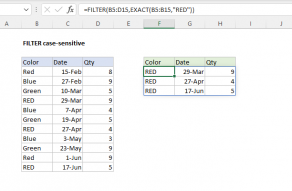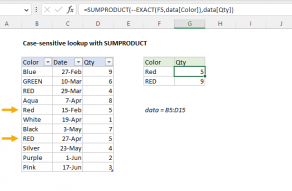Explanation
In this example, the goal is to perform a case-sensitive lookup on the first name in column B, based on a lookup value in cell F6. By default, Excel is not case-sensitive and this applies to standard lookup formulas like VLOOKUP, XLOOKUP, and INDEX and MATCH. These formulas will simply return the first match, ignoring case. For example, the formula in cell G5 is a standard INDEX and MATCH formula that is not case-sensitive:
=INDEX(data,MATCH(F5,data[First],0),3) // returns "Sales"
Since MATCH is not case sensitive, it returns the first match for "Janet" in row 2 of the table, even though the lookup value is "JANET" in uppercase.
We need a way to get Excel to compare case. The EXACT function is perfect for this task, but the way we use it is a little unusual. Instead of comparing one text value to another, we compare one text value to many values. In a nutshell, we use the EXACT function to generate an array of TRUE and FALSE values, then use the MATCH function to locate the first TRUE.
Background reading
This article assumes you are familiar with Excel Tables and INDEX and MATCH. If not, see:
- Excel Tables - introduction and overview
- How to use INDEX and MATCH - overview with simple examples
EXACT function
Working from the inside out, we first use the EXACT function to compare the lookup value in F6 with every value in the "First" column in the table:
EXACT(F6,data[First])
Because we give EXACT an array of values as a second argument, we will get back an array of TRUE and FALSE results. The first 10 results in this array look like this:
{FALSE;FALSE;FALSE;FALSE;FALSE;TRUE;FALSE;FALSE;FALSE;FALSE;...
Note: the actual array will contain 100 values since there are 100 rows in the table.
This array is created by checking the value in F6 against every cell in the "First" column of the table. A TRUE value indicates an exact, case-sensitive match. A FALSE value means no exact match. Based on the results above, we have an exact match at row 6 of the table.
MATCH function
Now we need to get the position (row number) of the TRUE value in this array. With INDEX and MATCH formulas, this is done with the MATCH function. The twist in this case is that we set up MATCH to look for TRUE instead of the original lookup value in F6:
MATCH(TRUE,EXACT(F6,data[First]),0) // returns 6
Inside the MATCH function, lookup_value is TRUE, lookup_array comes from EXACT, and the match_type argument is set to 0 for exact match. It may seem strange to ask MATCH to look for TRUE, but remember that the EXACT function is creating an array of TRUE and FALSE values. When EXACT delivers this array to MATCH, the original data is no longer available. The MATCH function returns 6.
Note: MATCH will always return the first match if there are duplicate lookup values.
INDEX and MATCH
Now that we have a row number, we just need to use the INDEX function to retrieve the value at the right row and column intersection. The MATCH function returns the number 6 for row_num, as explained above. The column_num argument is hardcoded as 3, since array is given as data, which includes all three columns. The final formula is:
=INDEX(data,MATCH(TRUE,EXACT(F6,data[First]),0),3)
With a row number of 6 and a column number of 3, INDEX returns a final result of "Fulfillment".
With XLOOKUP
With the XLOOKUP function, we can build a more compact formula with the same result:
=XLOOKUP(TRUE,EXACT(F6,data[First]),data[Department])
This formula works exactly the same as the INDEX and MATCH option explained above. The EXACT function is used to compare all values in the "First" column of the table with the value in cell F6. The result is returned directly to XLOOKUP as the lookup_array. The lookup_value is set to TRUE, and return_array is the "Department" column. For a more detailed explanation of XLOOKUP, see this example.















